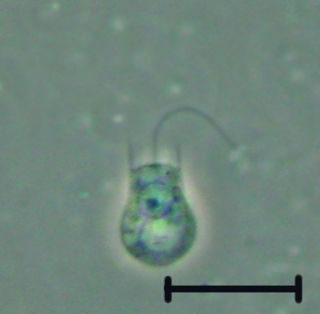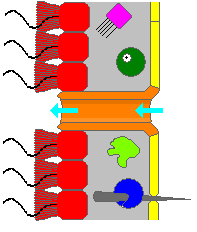
Sponges, the members of the phylum Porifera, are a basal animal clade as a sister of the diploblasts. They are multicellular organisms that have bodies full of pores and channels allowing water to circulate through them, consisting of jelly-like mesohyl sandwiched between two thin layers of cells.

The choanoflagellates are a group of free-living unicellular and colonial flagellate eukaryotes considered to be the closest living relatives of the animals. Choanoflagellates are collared flagellates, having a funnel shaped collar of interconnected microvilli at the base of a flagellum. Choanoflagellates are capable of both asexual and sexual reproduction. They have a distinctive cell morphology characterized by an ovoid or spherical cell body 3–10 μm in diameter with a single apical flagellum surrounded by a collar of 30–40 microvilli. Movement of the flagellum creates water currents that can propel free-swimming choanoflagellates through the water column and trap bacteria and detritus against the collar of microvilli, where these foodstuffs are engulfed. This feeding provides a critical link within the global carbon cycle, linking trophic levels. In addition to their critical ecological roles, choanoflagellates are of particular interest to evolutionary biologists studying the origins of multicellularity in animals. As the closest living relatives of animals, choanoflagellates serve as a useful model for reconstructions of the last unicellular ancestor of animals.

Filter feeders are aquatic animals that acquire nutrients by feeding on organic matters, food particles or smaller organisms suspended in water, typically by having the water pass over or through a specialized filtering organ. Filter feeders can play an important role in condensing biomass and removing excess nutrients from the local waterbody, and are therefore considered water-cleaning ecosystem engineers. They are also important in bioaccumulation and, as a result, as indicator organisms.
A spongocoel, also called paragaster, is the large, central cavity of sponges. Water enters the spongocoel through hundreds of tiny pores (ostia) and exits through the larger opening (osculum). Depending on the body plan of the sponge, the spongocoel could be a simple interior space of the sponge or a complexly branched inner structure. Regardless of body plan or class, the spongocoel is lined with choanocytes, which have flagella that push water through the spongocoel, creating a current.
Porocytes are tubular cells which make up the pores of a sponge known as ostia.

Cliona celata, occasionally called the boring sponge, is a species of demosponge belonging the family Clionaidae. It is found worldwide. This sponge creates round holes up to 5 millimetres (0.20 in) in diameter in limestone or the shells of molluscs, especially oysters. The sponge itself is often visible as a rather featureless yellow or orange lump at the bottom of the hole.

Anheteromeyenia argyrosperma is a freshwater sponge found across North America.
The Urmetazoan is the hypothetical last common ancestor of all animals, or metazoans. It is universally accepted to be a multicellular heterotroph — with the novelties of a germline and oogamy, an extracellular matrix (ECM) and basement membrane, cell-cell and cell-ECM adhesions and signaling pathways, collagen IV and fibrillar collagen, different cell types, spatial regulation and a complex developmental plan, and relegated unicellular stages.

Holozoa is a clade of organisms that includes animals and their closest single-celled relatives, but excludes fungi and all other organisms. Together they amount to more than 1.5 million species of purely heterotrophic organisms, including around 300 unicellular species. It consists of various subgroups, namely Metazoa and the protists Choanoflagellata, Filasterea, Pluriformea and Ichthyosporea. Along with fungi and some other groups, Holozoa is part of the Opisthokonta, a supergroup of eukaryotes. Choanofila was previously used as the name for a group similar in composition to Holozoa, but its usage is discouraged now because it excludes animals and is therefore paraphyletic.

Xestospongia testudinaria is a species of barrel sponge in the family Petrosiidae. More commonly known as Giant Barrel Sponges, they have the basic structure of a typical sponge. Their body is made of a reticulation of cells aggregate on a siliceous scaffold composed of small spikes called spicules. Water is taken into the inner chamber of the sponge through ostia. Flagellated choanocytes line the inner chamber and help generate water currents through the sponge.
The choanoderm is a type of cell layer composed of flagellated collar cells, or choanocytes, found in sponges. The sponge body is mostly a connective tissue; the mesohyl, over which are applied epithelioid monolayers of cells, the outer pinacoderm and the inner choanoderm.

Amphimedon compressa, the erect rope sponge, red tree sponge, red tubular sponge, or red sponge is a demosponge found in southern Florida, the Caribbean Sea, and the Bahamas. It can be deep red, orange, brown, or black.

Callyspongia (Cladochalina) aculeata, commonly known as the branching vase sponge is a species of sea sponge in the family Callyspongiidae. Poriferans are typically characterized by ostia, pores that filter out plankton, with an osculum as the opening which water leaves through, and choanocytes trap food particles.
Agelas schmidti, commonly known as the brown tubular sponge, is a species of demosponge. It occurs at moderate depths in the Gulf of Mexico and the Caribbean Sea and often has a colonial coral growing over the surface. The type locality is Puerto Rico.
Neofibularia nolitangere, commonly known as the touch-me-not sponge, is a species of sea sponge in the family Biemnidae. It is found in shallow waters in the Western Atlantic Ocean and the Caribbean Sea.

Callyspongia truncata is a species of marine sea sponge. Like all marine sponges, C. truncata is a member of phylum Porifera and is defined by its filter-feeding lifestyle and flagellated choanocytes, or collar cells, that allow for water movement and feeding. It is a species of demosponge and a member of Demospongiae, the largest class of sponges as well as the family Callyspongiidae. C. truncata is most well known for being the organism from which the polyketide Callystatin A was identified. Callystatin A is a polyketide natural product from the leptomycin family of antibiotics. It was first isolated in 1997 from this organism, which was collected from the Goto Islands in the Nagasaki Prefecture of Japan by the Kobayashi group. Recent studies have revealed numerous other bioactive compounds that have been found in this species.

Until the late 1950s, the Precambrian was not believed to have hosted multicellular organisms. However, with radiometric dating techniques, it has been found that fossils initially found in the Ediacara Hills in Southern Australia date back to the late Precambrian. These fossils are body impressions of organisms shaped like disks, fronds and some with ribbon patterns that were most likely tentacles.

Salpingoeca rosetta is a species of Choanoflagellates in the family Salpingoecidae. It is a rare marine eukaryote consisting of a number of cells embedded in a jelly-like matrix. This organism demonstrates a very primitive level of cell differentiation and specialization. This is seen with flagellated cells and their collar structures that move the cell colony through the water.
Similar low level cellular differentiation and specification can also be seen in sponges. They also have collar cells and amoeboid cells arranged in a gelatinous matrix.
Unlike S. rosetta, sponges also have other cell-types that can perform different functions. Also, the collar cells of sponges beat within canals in the sponge body, whereas Salpingoeca rosetta's collar cells reside on the inside and it lacks internal canals. Despite these minor differences, there is strong evidence that Proterospongia and Metazoa are highly related.

Eocyathispongia is a genus of sponge-like organisms which lived in the Ediacaran period about 60 million years before the Cambrian. The current fossil record has found this genus in only one location, the Doushantuo Formation in Guizhou, China. It lived in the shallow parts of seas, filter feeding.
Halisarca caerulea is a species of sponge in the family Halisarcidae. It is native to the Caribbean Sea and was first described in 1987 by the French marine biologists Jean Vacelet and Claude Donadey.














